You’re gonna love this zesty Chinese Broccoli recipe (or Gai Lan recipe), the superhero of Chinese vegetables. Tender, leafy greens, dressed up in a snazzy garlic and ginger miso ensemble, ready to give your taste buds a kick in the pants. Whether you’re a die-hard vegan, a Paleo enthusiast, or on the Whole30 train, this is the dish for you. Keto and low carb fans, we’ve got your back too. Go ahead and grab that large skillet or wok, and let’s turn those humble greens into your next favorite Asian cuisine.
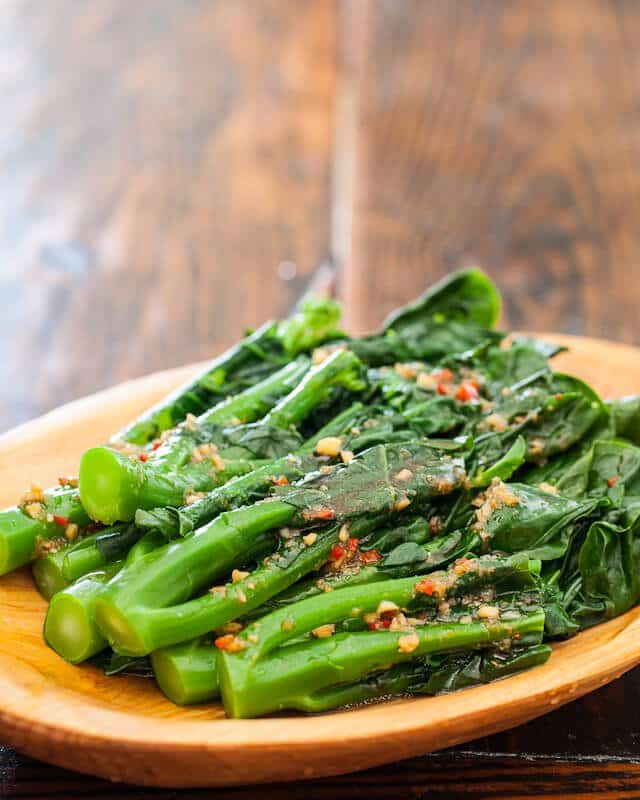
What you’ll learn in this recipe:
- How to tell if the Chinese broccoli is fresh
- Cooks stems first, then add leaves to prevent over/under cooking
- Savory garlicky ginger miso sauce that pairs well with any vegetable dish
Why This Recipe Works
- Quick & Easy: Who knew that a simple recipe could bring so much joy? This Chinese broccoli stir-fry is the easy peasy, lemon squeezy answer to your weeknight dinner dilemmas. With just a few minutes in a large wok or skillet and a handful of ingredients like garlic cloves, ginger, and miso paste, you’ve got a dish that’s faster than a takeout order from your favorite Chinese restaurant.
- Nutrition-Packed Powerhouse: Gai Lan, also known as Chinese kale, is one of my favorite vegetables because it’s wildly nutritious and packed with vitamins, with a slightly bitter taste that’s way more interesting than your average American broccoli.
- Versatile Veggie Victory: Whether you’re tossing it in as a side dish with white rice or brown rice, or mixing it into a larger stir-fry feast, this recipe is a champ at adapting. It’s like the Swiss Army knife of veggies – ready for anything, from a cozy family dinner to impressing your foodie friends at a potluck.
Ingredients
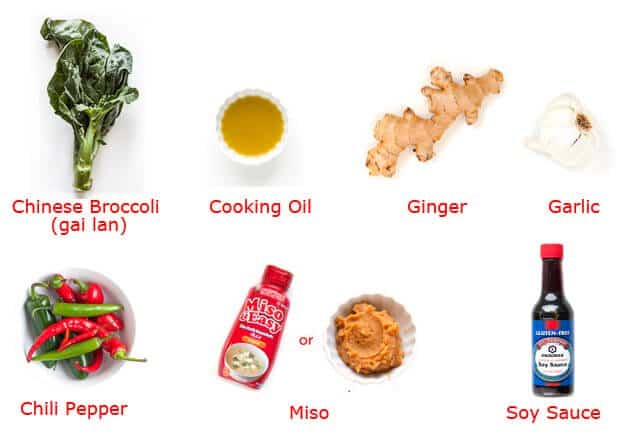
- Chinese broccoli
- Ginger
- Garlic
- Chili peppers
- Miso paste
- Soy sauce
How to Make Chinese Broccoli – Step by Step
Cut the Chinese broccoli like this, which helps the vegetable cook evenly. Gai lan stems are thick, so they go at the bottom of the pan, which is hotter.
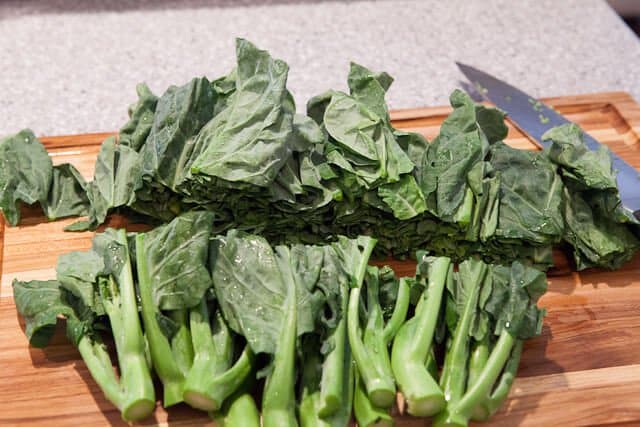
Add 1″ of water to your wok, then add the ends of the stalk in first, at the bottom.

Lay the leaves on top.
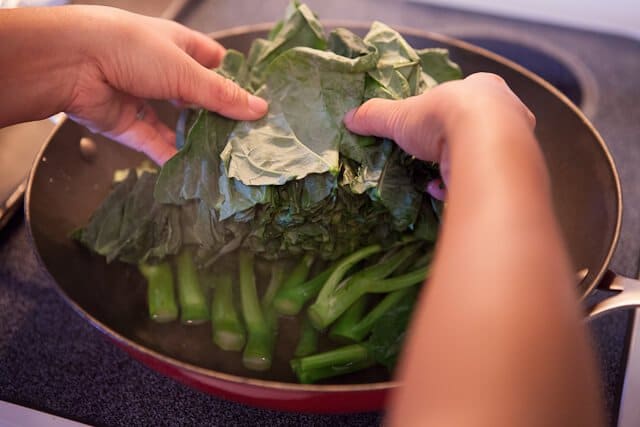
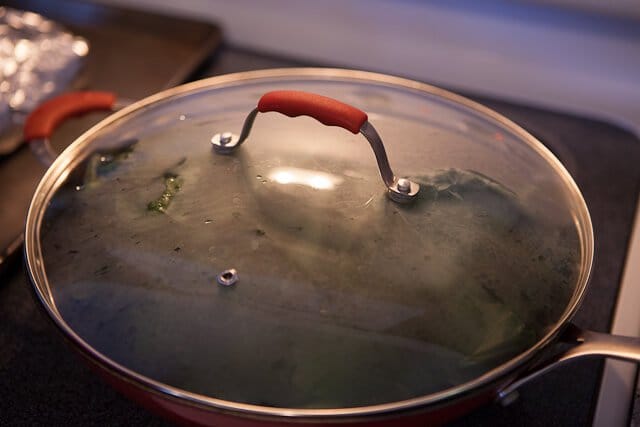
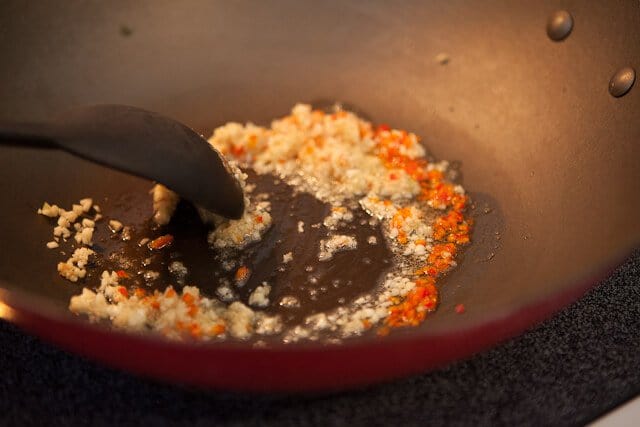

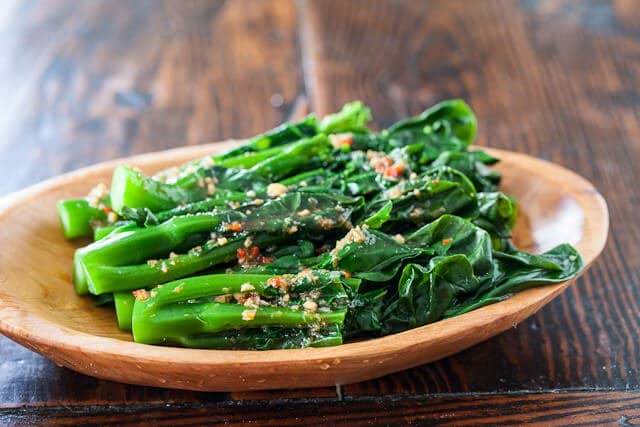
What Is Chinese Broccoli?
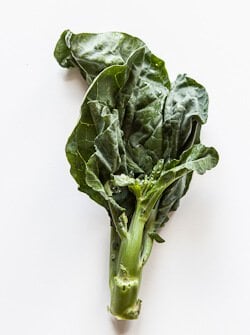
It comes from the same family as traditional broccoli, but it has a stronger, more pronounced taste. It’s bitter if you eat it raw, which is why it’s always cooked.
In Chinese, it’s gai lan or kai lan, pronounced “guy-LAN”. The stems are thick, the color of the leafy parts is more like kale (blue-green). While the florets of regular broccoli is eaten, many open florets on Chinese broccoli often means the vegetable is old and tough. The stems and leaves is what you eat.
Did you know that Broccolini is a cross between broccoli and gai-lan?
How to Tell if Chinese Broccoli is Fresh
For this and most other Chinese broccoli recipes you really want to use fresh broccoli. Chinese broccoli should have very few florets. If you see small white flowers blooming, it probably means it’s past its prime and will be tough and bitter.
Also take a look at the bottoms of the stem part. Fresh young Chinese broccoli will have a wet-milky-translucent-ish color in the center of the stem. Old Chinese broccoli stem will be dried up with a hard, white opaque center. Skip it.
Here’s a photo of fresh Gai Lan with soft, opaque-ish milky center.
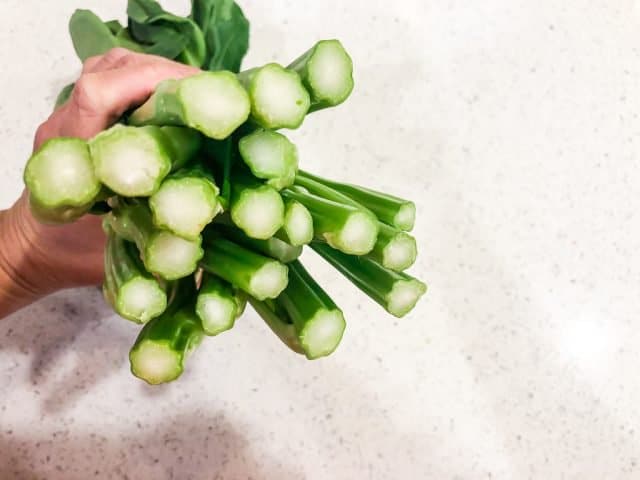
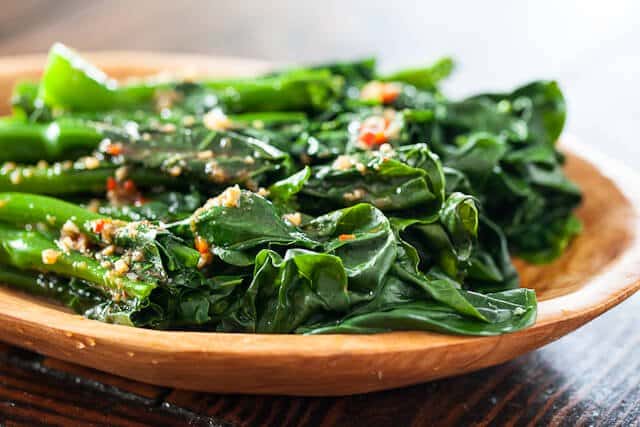
Health Benefits Of Chinese Broccoli
Like many leafy green vegetables, Chinese broccoli is a powerhouse of nutrients. It contains high amounts of beta carotene. Beta carotene helps prevent age related macular degeneration (ARMD), which causes vision loss and eventually blindness. Additionally, Chinese broccoli is a good source of vitamin E. Vitamin E can improve immune function, preventing viral and bacterial infections. This green is a great source of dietary fiber as well.
Top Tips for this Chinese Broccoli Recipe
- The broccoli stems are thicker and should go at the bottom of the pan, to cook evenly.
- Wipe off the water from the wok before you stir in the aromatics, this will prevent splattering.
- Fresh young Chinese broccoli will have a wet-milky-translucent-ish color in the center of the stem.
- You can substitute Chinese broccoli for broccolini. You can also use the same ingredients and sauce for almost all Asian vegetable stir-fries, for example, yu choy. The same seasonings also work for spinach and broccoli.
Chinese Broccoli FAQs
What exactly is Chinese broccoli, and how does it differ from regular broccoli?
Chinese broccoli, also known as Gai Lan or Chinese kale, is a leafy vegetable that’s a close cousin to the more familiar American broccoli. Unlike its cousin with thick stems and tiny florets, Chinese broccoli features flat leaves, open flowers, and a slightly bitter flavor. It’s a staple in Chinese food, especially in dishes like dim sum and stir fries.
Can I find the ingredients for this recipe at regular grocery stores?
Most of the ingredients like sesame oil, soy sauce, and garlic cloves are readily available at standard grocery stores. However, for more authentic flavors, a trip to Asian grocery stores might be your best bet. They’ll have a wider selection of ingredients specifically used in Chinese cooking.
Is this recipe suitable for a vegetarian or vegan diet?
Absolutely! This Chinese broccoli dish is a dream for vegetarians and vegans. It’s packed with plant-based goodness and doesn’t include any animal products, especially if you opt for vegetarian oyster sauce instead of the traditional kind. It’s a great dish to add to your green-eating repertoire.
Can I use a substitute for Chinese broccoli if I can’t find it?
Sure thing! While gai lan has its unique taste and texture, in a pinch, you can substitute it with broccoli rabe or even kale. These alternatives can mimic the leafy green vegetable experience, although the taste will be slightly different. Remember, cooking is all about improvisation and making it work for your palate.
What type of rice works best with this dish?
This Chinese broccoli recipe is quite versatile and pairs beautifully with any rice – be it white rice, brown rice, or even a bowl of sweet rice for a contrasting flavor. It’s all about your preference, so feel free to experiment!
Other Chinese Vegetable Recipes
Chinese Broccoli with Oyster Sauce (Steamy Kitchen)
Chinese Yu Choy Stir Fry (Steamy Kitchen)
Stir Fried Bok Choy Recipe (Steamy Kitchen)
Chinese Broccoli Beef Noodle Stir Fry (Steamy Kitchen)
Have you tried this Chinese Broccoli recipe? Feel free to leave a star rating and I’d love to hear from you in the comments below!
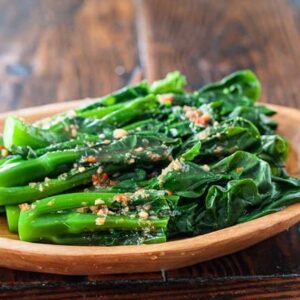
Chinese Broccoli with Garlicky Ginger Miso Recipe
Ingredients
- 1 pound Chinese broccoli gai lan
- 2 tablespoons cooking oil
- 1 teaspoon grated fresh ginger
- 2 cloves garlic finely minced
- 1 teaspoon hot chili pepper minced (optional)
- 1 1/2 tablespoons miso paste
- 2 tablespoons water
- 1 tablespoon soy sauce
- 1 teaspoon Asian sesame oil
Instructions
- Trim ends of the Chinese broccoli. Line up the Chinese broccoli with the stems facing same direction. Cut the stalks in half to separate the thick stems from the leaves.
- Add one inch of water to a wok, pot or large saute pan and bring to a simmer on medium heat. Layer in the broccoli stems at the bottom of the pan and layer the leaves on top of the stems. You want the thick stems closer to the bottom of the pan so that they will cook faster. Steam for 3 minutes. Use tongs to lift the leaves to a plate. Check the stems to make sure they are cooked - they should be easily pierced with a knife. Thicker stems might need an additional minute.
- Discard the remaining water in the pan and wipe dry with a towel. Return pan to the stove and add in the cooking oil and ginger, garlic and chile pepper. Turn the heat to medium-low. Once the oil in the wok begins shimmering, cook for another 15 seconds (take care not to burn the aromatics). Stir in the miso paste, water, soy sauce and sesame oil and cook another 15 seconds. Add the Chinese broccoli back into the pan, give everything a quick stir, then plate for serving.



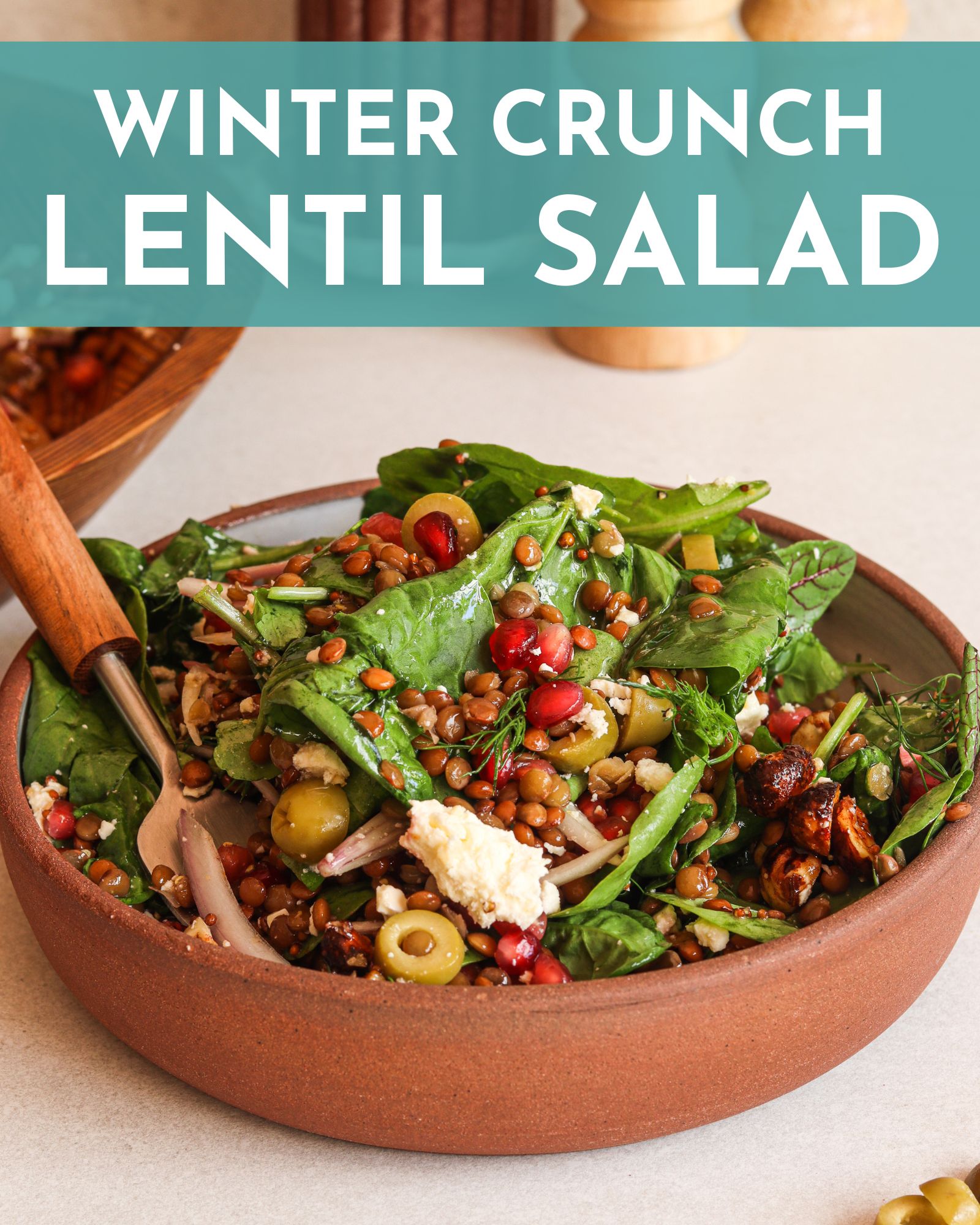


Excellent soup to make at home and enjoy with family. I truly appreciate the way you made it. Looking for more such delicious recipe in future.
i made this at 2am but added sliced king oyster mushrooms on top of the gai lan to steam them a little. then, i simmered both vegs in the simmering sauce added in some vermicelli rice noodles. one of the best dish i ever tasted! and simple
Thank you Tania! I love king oyster mushrooms too! jaden
Fabulous, thanks for posting!
I finally got around to making this gai lan dish and my daughter and I practically ate the whole thing. For some reason, I decided to double the sauce ingredients and felt that in the end I should have stuck with the original amounts stated in the recipe. After mixing my miso paste with hot water, I can see how Miso & Easy would make things easier. Thanks for another great recipe, Jaden.
I made this, altered slightly and used steamed veggies instead of the chinese broccoli. It was delicious! Thanks for sharing! 🙂
omg, that looks amazing!! i love chinese broccoli. like that this is a departure from the typical hoisin sauce.
Hi Jaden, is there any alternative for soy sauce? I am on a cleansing diet which requires that I avoid any soy products except Miso. Brocolli is one of the veggies that is recommended because of its high antioxidant quality.
So what can I use in replacement to soy sauce?
Help!
Mm,mm, and more mm. This looks sinfully good.
This recipe sounds great! How much sesame oil is required? It’s not in the ingredients list.
Thanks!
You’re right! i just fixed it. Thanks!
Great recipe! I love Chinese broccoli and bok choy.
(Pssst…it’s “Garlicky”, not “Garlicy” 😉
Yum! Another recipe using Miso & Easy!
Thanks for the tips on what to look for when buying Chinese broccoli! I can’t wait to try making it this way! I usually use oyster sauce or add it to a stir fry!
BTW, I love your wok!
looks good
I have cooked this twice in a week now! Simply wonderful. Thank you for sharing the recipe.
Hi Jaden, thanks for the link love. I love the idea of miso sauce with chilli for a vegetable stir-fry dish, gotta try it!
I’ve never heard of Chinese broccoli! It looks very good though, like some sort of bok choy broccoli hybrid. And I need to get me some of this easy miso stuff…
YUMMMMMM
Thanks for the link love. Great idea using miso in veggies!
I pass this stuff all the time and never know what to do with it so I don’t buy it. I’m going to rectify that!
This looks so good…can’t wait for my kailan to grow…I will have to go to the Asian market and buy some and make this.
I love this recipe.
Me too!
This is one of my favorite green veg in the world! Love having a new preparation idea.
The color is so vibrant! Love!
P.S. Have a blast in Chicago and make sure and eat at Rick Bayless restaurant and have some of his amazing Mexican Hot Chocolate!! 🙂
OMG get yourself to The Bedford in Wicker Park amazing seasonal food and my brother making awesome cocktails at the bar. I PROMISE you will NOT be disappointed!
this looks so delicious! love that color!
I spy your new wok! 🙂 I love broccolini and Chinese broccoli…need to cook with it more. I love that you’re showing me that miso is so versatile! Have fun in Chicago!